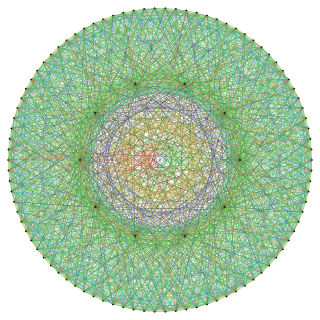
In the area of abstract algebra known as group theory, the monster group M (also known as the Fischer–Griess monster, or the friendly giant) is the largest sporadic simple group, having order
808,017,424,794,512,875,886,459,904,961,710,757,005,754,368,000,000,000
= 246 · 320 · 59 · 76 · 112 · 133 · 17 · 19 · 23 · 29 · 31 · 41 · 47 · 59 · 71
≈ 8×1053.

In mathematics, a simple group is a nontrivial group whose only normal subgroups are the trivial group and the group itself. A group that is not simple can be broken into two smaller groups, namely a nontrivial normal subgroup and the corresponding quotient group. This process can be repeated, and for finite groups one eventually arrives at uniquely determined simple groups, by the Jordan–Hölder theorem.

In the mathematical classification of finite simple groups, there are 26 or 27 groups which do not fit into any infinite family. These are called the sporadic simple groups, or the sporadic finite groups, or just the sporadic groups.

In the area of modern algebra known as group theory, the Conway groups are the three sporadic simple groups Co1, Co2 and Co3 along with the related finite group Co0 introduced by (Conway 1968, 1969).

In mathematics, especially in the group theoretic area of algebra, the projective linear group (also known as the projective general linear group or PGL) is the induced action of the general linear group of a vector space V on the associated projective space P(V). Explicitly, the projective linear group is the quotient group
In mathematics, the projective special linear group PSL(2, 7), isomorphic to GL(3, 2), is a finite simple group that has important applications in algebra, geometry, and number theory. It is the automorphism group of the Klein quartic as well as the symmetry group of the Fano plane. With 168 elements, PSL(2, 7) is the smallest nonabelian simple group after the alternating group A5 with 60 elements, isomorphic to PSL(2, 5).

In the area of modern algebra known as group theory, the Higman–Sims group HS is a sporadic simple group of order

In the mathematical field of graph theory, the Hall–Janko graph, also known as the Hall-Janko-Wales graph, is a 36-regular undirected graph with 100 vertices and 1800 edges.

In the area of modern algebra known as group theory, the Rudvalis groupRu is a sporadic simple group of order

In the area of modern algebra known as group theory, the Janko groupJ1 is a sporadic simple group of order

In the area of modern algebra known as group theory, the Janko groupJ2 or the Hall-Janko groupHJ is a sporadic simple group of order
In group theory, a branch of mathematics, the automorphisms and outer automorphisms of the symmetric groups and alternating groups are both standard examples of these automorphisms, and objects of study in their own right, particularly the exceptional outer automorphism of S6, the symmetric group on 6 elements.

In the area of modern algebra known as group theory, the Mathieu groupM22 is a sporadic simple group of order

In the area of modern algebra known as group theory, the Mathieu groupM24 is a sporadic simple group of order

In the area of modern algebra known as group theory, the McLaughlin group McL is a sporadic simple group of order
In mathematical physics, higher-dimensional gamma matrices generalize to arbitrary dimension the four-dimensional Gamma matrices of Dirac, which are a mainstay of relativistic quantum mechanics. They are utilized in relativistically invariant wave equations for fermions in arbitrary space-time dimensions, notably in string theory and supergravity. The Weyl–Brauer matrices provide an explicit construction of higher-dimensional gamma matrices for Weyl spinors. Gamma matrices also appear in generic settings in Riemannian geometry, particularly when a spin structure can be defined.

In the area of modern algebra known as group theory, the Conway groupCo2 is a sporadic simple group of order

In the area of modern algebra known as group theory, the Conway group is a sporadic simple group of order

In the area of modern algebra known as group theory, the Conway groupCo1 is a sporadic simple group of order












